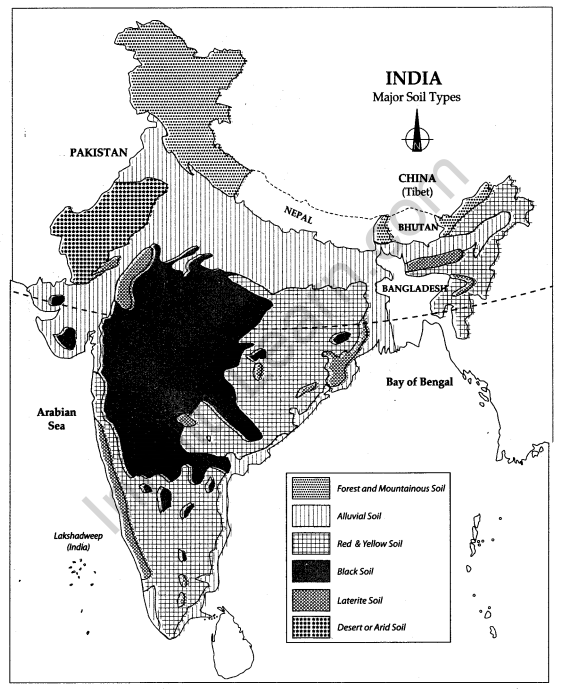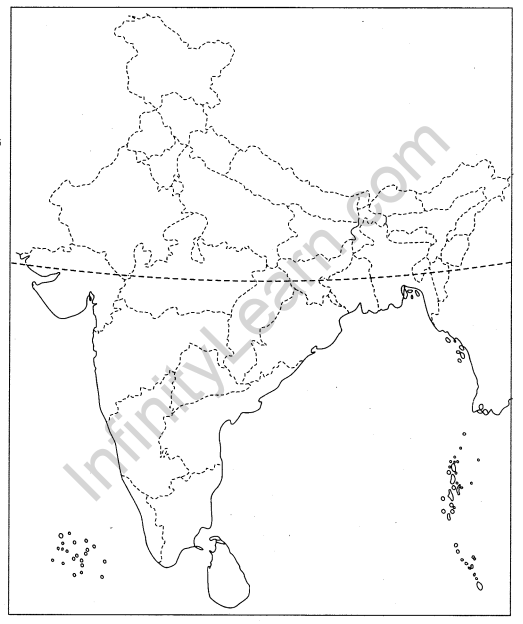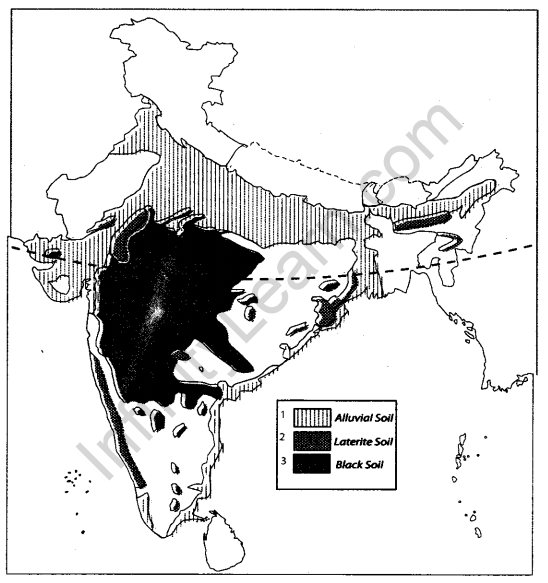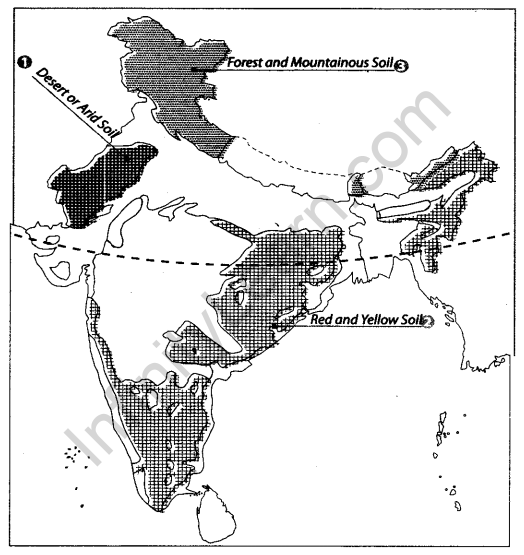Table of Contents
NCERT Solutions for Class 10 Geography Chapter 1 – Resources and Development provide valuable assistance for students studying for CBSE exams. These solutions offer a clear understanding of how to answer questions effectively, aiding students in achieving higher marks. Crafted by subject experts, these solutions equip students with the necessary knowledge to excel in their Social Science exams.
Class 10 Geography Map Work Chapter 1 Resource and Development
Six different types of soils are found in India. These are Alluvial soil, Red soil, Black soil, Laterite soil, Mountain soil and Desert soil or Arid soil. Soils in India differ in composition and structure. This map shows the major soil types in India.

Question 1.Locate and label the following items on the given map with appropriate symbols.
1. Regions covered under Alluvial soil [CBSE 2016, 10]
2. Regions covered under Laterite Soil
3. Regions covered under Black soil [CBSE 2012, 11]

Answer

Question 2. Features are marked by numbers in the given outline map of India. Identify these features with the help of the following information and write their correct names on the lines marked in the map.
1. A major soil type [CBSE 2012, 11,10]
2. Soil type that is formed where the rainfall is low [CBSE 2012, 10]
3. Soil type found mainly in hill slopes

Answer
1. Desert or Arid soil
2. Red and Yellow soil
3. Forest and Mountainous soil

We hope the given CBSE Class 10 Geography Map Work Chapter 1 Resource and Development will help you. If you have any query regarding NCERT Class 10 Geography Map Work Chapter 1 Resource and Development, drop a comment below and we will get back to you at the earliest.
NCERT Solutions for Class 10 Geography Chapter 1 – Resources and Development
1. Multiple choice questions.
(i) Which one of the following types of resource is iron ore?
(a) Renewable
(b) Biotic
(c) Flow
(d) Non-renewable
Answer:
Non-renewable
(ii) Under which of the following type of resources can tidal energy not be put?
(a) Replenishable
(b) Human-made
(c) Abiotic
(d) Non-recyclable
Answer:
Replenishable
(iii) Which one of the following is the main cause of land degradation in Punjab?
(a) Intensive cultivation
(b) Deforestation
(c) Over-irrigation
(d) Overgrazing
Answer:
Over-irrigation

(iv) In which one of the following states is terrace cultivation practised?
(a) Punjab
(b) Plains of Uttar Pradesh
(c) Haryana
(d) Uttarakhand
Answer:
Uttarakhand
(v) In which of the following states is black soil predominantly found?
(a) Jammu and Kashmir
(b) Maharashtra
(c) Rajasthan
(d) Jharkhand
Answer:
Maharashtra
2. Answer the following questions in about 120 words.
(i) Explain the land use pattern in India and why has the land under forest not increased much since 1960-61.
Answer:
The use of land is determined both by physical factors, such as topography, climate, and soil types, as well as by human factors, such as population density, technological capability, culture, traditions etc. The pattern of the net sown area varies greatly from one state to another. It is over 80 per cent of the total area in Punjab and Haryana and less than 10 per cent in Arunachal Pradesh, Mizoram, Manipur and Andaman Nicobar Islands. Forest area in the country is far lower than the desired 33 per cent of the geographical area, as it was outlined in the National Forest Policy (1952). It was considered essential for the maintenance of the ecological balance. A part of the land is termed a wasteland, and it is put to other non-agricultural uses like settlements, roads, railways, industry etc. It includes rocky, arid and desert areas. Continuous use of land over a long period of time without taking appropriate measures to conserve and manage it has resulted in land degradation.
(ii) How has technical and economic development led to more consumption of resources?
Answer:
There are various reasons for this.
- Large-scale production led to over utilisation of resources.
- Technological advancement led to greater exploitation of resources.
- Improved medical and health resources led to huge consumption of resources.
3. Answer the following questions in about 30 words.
(i) Name three states having black soil and the crop which is mainly grown in it.
Answer:
3 states are
- Maharashtra
- Gujarat
- Madhya Pradesh
The crop grown is cotton.
(ii) What type of soil is found in the river deltas of the eastern coast? Give three main features of this type of soil.
Answer:
The type of soil found in river deltas is Alluvial Soil.
- It is very fertile and, therefore, good for the cultivation of crops
- It consists of various proportions of sand, silt and clay
- Alluvial soil has a good quantity of potash, lime and phosphoric acid, which is good for the growth of paddy and sugarcane.
(iii) What steps can be taken to control soil erosion in hilly areas?
Answer:
The main techniques that can be used are given below.
- Contour ploughing
- Terrace farming
- Strips of grass are allowed to grow between the crops. This method is known as strip cropping.
(iv) What are the biotic and abiotic resources? Give some examples.
Answer:
Biotic resource:
- These are resources that are obtained from the biosphere
- These resources have life
- Examples are plants, animals, fish, human beings, livestock etc.
Abiotic resource:
- These resources are composed of non-living things
- Examples are water, minerals, metals, wind, solar energy etc.





